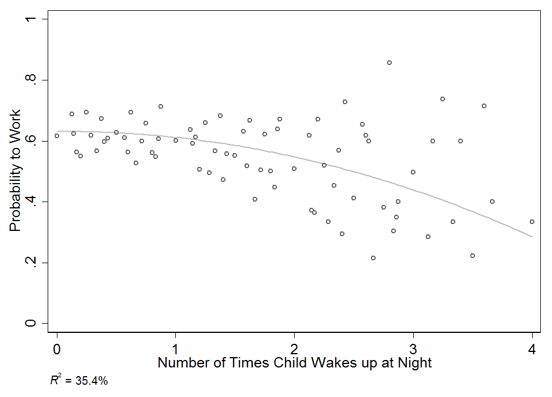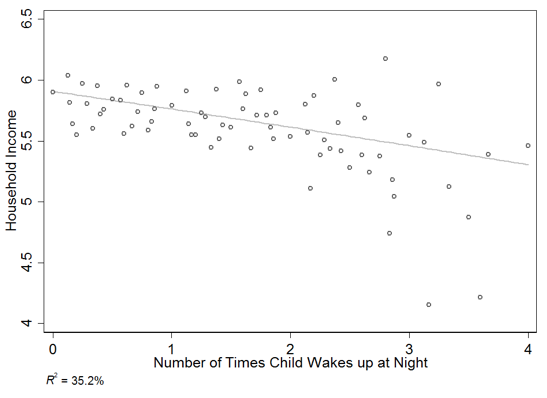Lack of sleep is responsible for human fatigue, and can undermine economic performance. Paradoxically, the question of whether sleeping is a productive activity or not has received very limited attention in economics research so far. Sleep is often overlooked in economics models despite its obvious restorative effects on human health alongside its influence on brain plasticity and feelings of wellbeing. Sleep exerts an influence on emotional wellbeing and restful perceptions, and sleep deprivation more generally, even when moderate, is found to be detrimental to employment behaviours. The number of hours the average person sleeps has declined over the past century, yet we still ignore its effects on economic activity and economic performance.
Children's sleeping patterns as an experiment
Although sleep deprivation can have several triggers such as round-the-clock access to technology, time, and work schedules alongside changes in light and noise, there is evidence of household-derived sleep deprivation. Specifically, sleep deprivation resulting from children's sleep routines together with increasing parental involvement and parental sharing in child-rearing duties makes child-related sleep deprivation a potential source of variation in adult sleep. This is especially the case when we control for other variables, including parental coordination efficiency.
What has the economics literature found so far?
Seminal work by Biddle and Hamermesh (1990) developed an optimal model of time allocation including sleep. They use a cross-section of time-use survey data and estimate that a one-hour increase in paid work reduces sleep by 10 minutes, and more generally they reveal the effect of opportunity cost of sleep on wages. Hamermesh et al. (2008) examine how cues such as TV programmes and sunlight affect sleep and coordination.
Other economic influences on sleep include the effect of income and education: one would expect that they influence the opportunity costs of sleep, but especially sleep efficiency. Indeed, more affluent individuals appear to take longer to get to sleep, but are more efficient in their sleep (Gardner et al. 2010). However, income differences in sleep problems no longer appear significant when health and other characteristics are adjusted.
Other studies focus on the labour market effects of sleep. Kamstra et al. (2000) find an influence of sleep on financial market performance; Szalatonai (2006) and Brochu et al. (2012) estimate the impact of changes on income and wages respectively; and Bonke (2012) examines effects on productivity. Antillon et al. (2014) examine the effect of unemployment on sleep and find evidence of sleep being countercyclical, but Ásgeirsdóttir and Ólafsson (2015) find a relationship between sleep duration and employment. Nevertheless, this literature does not develop the link between child sleep quality and parental sleep quality.
Only one paper deals with the endogeneity of sleep quality by using instrumental variables approach as we do here. Gibson and Shrader (2015) instrument for sleep quality by using the short- and long-term sunset time. Gibson and Shrader (2015) estimate the short-term effect of a reduction of one-hour sleep on wages to be 1.5%, and the long-term effect to be 5%. The problem with this study is that they rely on location-level variations, and therefore their estimates should not be interpreted as individual effects. They potentially include spillovers across people who live in the same location. The advantage of our approach is that we exploit individual variations in sleep quality, due to changes in child sleep duration and the number of times a child wakes up at night.
Our data: The Avon Longitudinal Study of Parents and Children (ALSPAC)
We rely on a unique dataset for the UK – a cohort study which follows a sample of 14,000 families from a child’s birth to age 25. More specifically, it contains records of mothers since pregnancy and, crucially for our paper, has the advantage of including a rich and validated set of measures of both parental and child sleep alongside a set of other variables to be employed as controls and employment outcomes. For instance, it contains very precise information on the child's quality of sleep, including whether the child wakes up at night, sleep time and day sleep, as well as child sleeping routines and environmental triggers of sleep quality. We can then relate these measures to objective and subjective measures of parental sleep quality, including average sleep duration, and whether the mother/father feels they had enough sleep. Another advantage is that the data provide us with information on both maternal and paternal employment characteristics, including employment status, the number of hours worked, job satisfaction, and income for parents on a longitudinal basis.
Findings
Figures 1 and 2 display the association between two employment outcomes (both the probability of mother’s employment and her household income) on the number of times the child wakes up at night for a sample of 10,000 children (see below for data details). In both cases, the figures show a strong negative relationship. Consistently, our main finding confirms that the relationship between sleep and employment outcomes works through the channels we consider: (i) child sleep quality is a major driver of parental sleep quality; and (ii) parental sleep quality is strongly correlated with parental employment and working-time decisions. Our two-stage least squares estimates of the effect of parental sleep on economic performance are substantial. We find that improving the mother’s average nightly sleep duration by one hour increases employment by 4 percentage points, the number of hours worked by 7%, household income by 10-11% and job satisfaction by 0.01 points.
Figure 1 Reduced-form relationship between mother’s probability of working and the number of times child wakes up at night
Figure 2 Reduced-form relationship between household income and number of times child wakes up at night
So what?
Sleep is a major determinant of employment outcomes that deserves attention when designing employment policies. The estimated effect of sleep in our study can be attributed to changes in child sleep quality. To our knowledge, this is the first paper that finds a link between child sleep quality and parental economic performance. The average effects mask substantial heterogeneity: fathers are somewhat less affected by child sleep problems; similarly, the probability of high-skilled mothers working is not affected when children wake up at night. Low-skilled mothers instead experience a large decrease in employment and the number of hours worked when facing sleep deprivation.
References
Antillón, M, D S Lauderdale and J Mullahy (2014), “Sleep behavior and unemployment conditions”, Economics & Human Biology 14: 22–32.
Ásgeirsdóttir, T L and S P Ólafsson (2015), “An empirical analysis of the demand for sleep: Evidence from the american time use survey”, Economics & Human Biology 19: 265-274.
Biddle, J and D Hamermesh (1990), “Sleep and the Allocation of Time”, Journal of Political Economy 98(5): 922–943.
Bonke, J (2012), “Do morning-type people earn more than evening-type people? How chronotypes influence income”, Annals of Economics and Statistics: 55-72.
Costa-Font, J and S Flèche (2017), “Parental Sleep and Employment: Evidence from a British Cohort Study”, CEP Discussion Paper No 1467.
Gibson, M and J Shrader (2014), “Time use and productivity: the wage returns to sleep”, available at http://econweb.ucsd.edu/~magibson/pdfs/sleep_productivity.pdf
Hamermersh, D S, C Knowles Myres and A L Pocock (2008), “Cues for Timing and Coordination: Latitude, Letterman and Longitude,” Journal of Labour Economics 26(2): 223-247.
Kamstra, M J, L A Kramer and M D Levi (2000), “Losing sleep at the market: the daylight saving anomaly”, American Economic Review 1005–1011.





